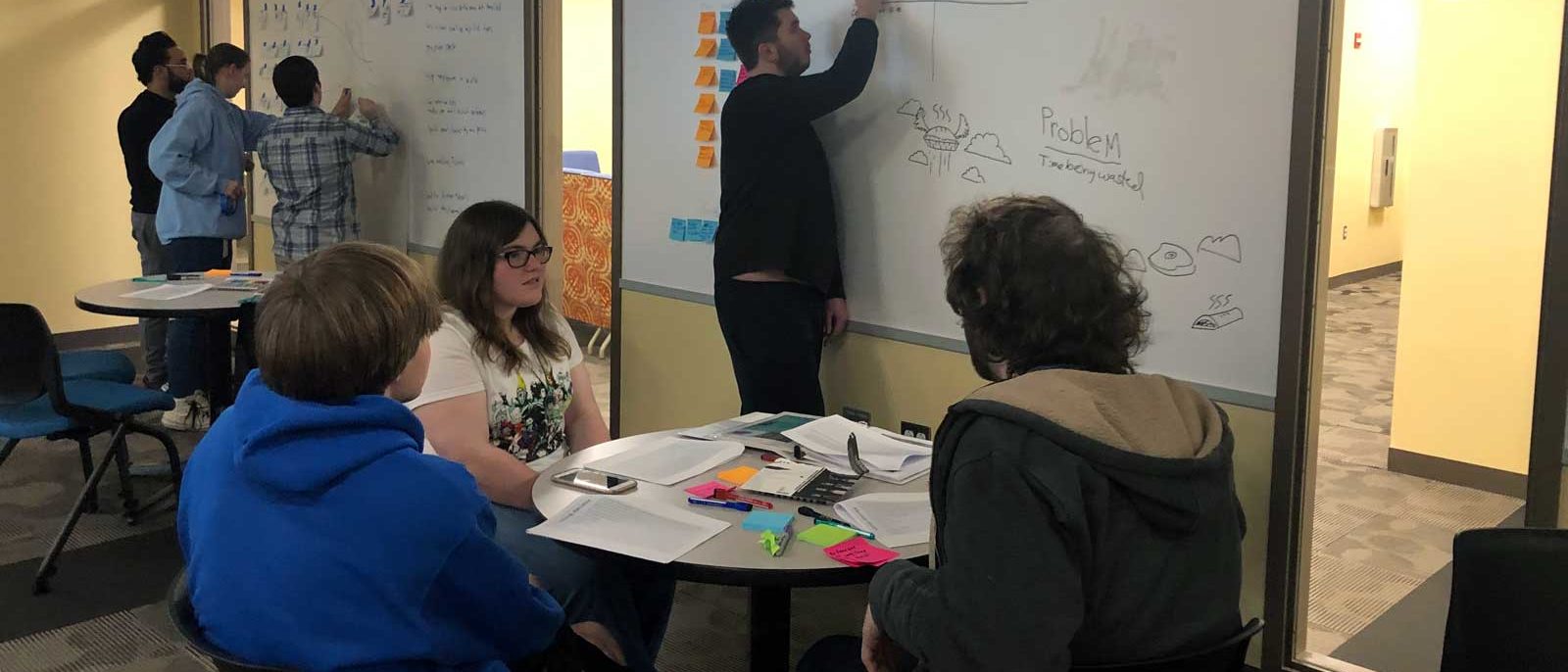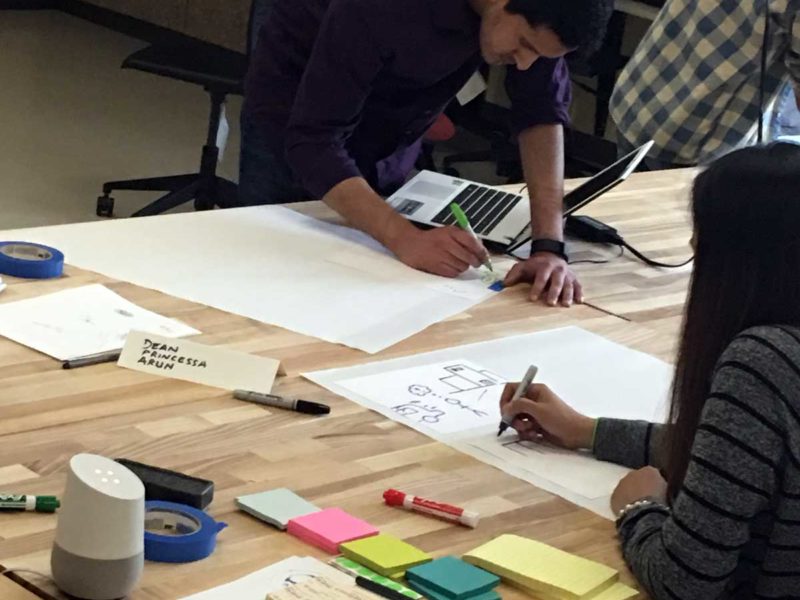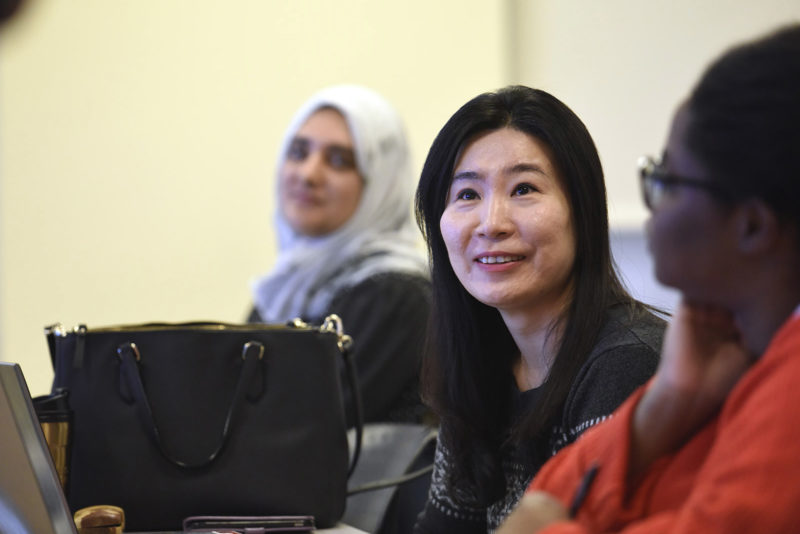Master of ScienceHuman-Centered Interaction Design
It’s a wonderful thing when one of the fastest-growing tech-related career fields is accessible to you – even if you don’t hold a tech-related degree. In fact, having a liberal arts, humanities, or social and behavioral science background actually makes you a better fit for the Human-Centered Interaction Design (HCID) field than the techies!
Apply Now Request Info
This master’s degree program is about designing processes, apps and environments to make more fulfilling and useful experiences for people.
According to the Harvard Business Review there is strong corporate interest in “design thinking” as a way to open businesses to new markets through innovating new human-centered products and experiences. The career possibilities are endless and industry is clamoring for those qualified to bridge the gap between environments, technologies and the public. It requires creativity, empathy for people and strong problem-solving skills. For example, once you’ve completed your MS degree, your work could involve:
- Designing food-ordering kiosks that are intuitive, easy to use and people-friendly
- Using your knowledge to redesign the experience of a museum to allow visitors flexible and enriching interaction with exhibits.
- Reconfiguring an MRI room in a hospital to engage children rather than intimidate them
Ultimately, you will gain the skills to design effective and engaging interfaces, interactions, and user experiences that leverage the best of digital technologies and bring them seamlessly into complex human environments. The degree is intended to train individuals with liberal arts, humanities, business and technology backgrounds for careers in the rapidly growing field of UX research, digital service design, and interactive product strategy and design. Job titles possible for students after graduation would include UX Researcher, Interaction designer, UX designer, Information architect, Interactive systems designer, Digital systems analyst, and Digital services (or UX) manager.
Program Lead
Full Time Faculty
Nathan Aileo
Assistant Professor of Human Centered Interaction Design
Corporate Faculty
Program Courses
This program requires a total of 36 semester hours: 18 semester hours from the core courses listed below, 6 semester hours of experiential courses, and 12 semester hours of Individualized Concentration courses. The semester hour value of each course appears in parentheses ( ).
HCID 500 –
Design Perspectives
(3 credits)
This course will introduce the student to the design perspectives encountered most often in human-centered interaction design. Design perspectives are attitudes towards how to do design which reflect their political, social, and technological beliefs about design practice. Through readings and case studies, the student explores a variety of perspectives in the domain of digital interactive design. The student delves into the foundations of design practice through different standpoints, histories, frames of reference and interpretations of different views of the ‘best’ way to design.
HCID 504 –
Methods for Design Research
(3 credits)
This course will introduce the student to the package of study design and research methods employed within human-centered interaction design. In this process-driven course, the lessons will be structured around design research methodology, execution, and reporting. The course will take place as a series of situation studios, in which the student engages their evolving design eye and research skills to research the people, processes, contexts, and temporalities of digital interaction opportunities. Through readings, discussions, and the exploration of examples, guidelines, and heuristics, the course engages the student in the ethical and entrepreneurial aspects of design research within design practice.
HCID 510 –
Human Sociotechnical Interactions
(3 credits)
This course will introduce the student to the theories and perspectives of human social behavior that are employed most often in HCID. Drawing on canonical and new sociotechnical science literature, the course will present the student with overviews of theories of information, action, sociality, conflict, and interaction within traditional and digital environments. Through readings and examples, the course includes attention to sociotechnical theories around communities of practice, online communities, social media, and enterprise knowledge management. This seminar course offers the student a better understanding of the contexts and perspectives within which people interact with others, around and through offline, online, and hybrid environments.
HCID 520 –
Users and Populations
(3 credits)
This course will introduce the student to the design-based theories and contexts of users and populations, as found in human-centered interaction design. The course will be structured around three design contexts: cohorts; environments; and capabilities. The course will take place as a series of case-based seminars. Through readings, discussions, and the exploration of examples and heuristics, the course draws the student’s attention to the need to develop their design eye for contextual integration of user and population theory within design practice.
HCID 540 –
Design Tools and Processes
(3 credits)
This course offers the student the opportunity to work with a variety of tools and processes that support design practice. The course exposes the student to traditional and digital tools, templates, and techniques for design. Using an example project supplied by the professor, the course is run as a series of studios. After using tools and processes in each stage of the design process, the student reflects on the suitability and use case for each tool and reflect of their evolving sense of self as a designer. The course covers the tools, processes, and techniques necessary to professionalize the student’s design practice.
HCID 570 –
Design Patterns and Contexts
(3 credits)
This course introduces the student to the contextual design of patterned interfaces in human-centered interaction design. The course is structured as a series of seminars around four design area: contexts; visuals; patterns; and actions. Taking the approach of goal-driven design, the student will engage in reading, discussing, experimenting, and presenting design rationales for design choices around traditional and new digital interfaces. The course builds on what the student learned in the other courses and intensifies the student’s development of their design eye for contextually sensitive interaction design. The student will be challenged to consider areas of conflict and divergence within design thinking. While employing their own evolving capacity for design, the student will learn to manage conflicts between goal orientations, contextual needs, and environmental challenges.
CISC 160 –
Data Structures
(3 credits)
This lecture and laboratory course further develops the concepts and techniques of computer programming. Emphasis is placed on structured programming, top-down design, more advanced data structures, and the proper use of the programming language and development tools. Topics include abstract data types (ADTs), sets, records, recursion, problem solving and algorithms, fundamental computing algorithms, searching, introductory sorting, hash tables, basic algorithm analysis, Object-Oriented Programming (OOP), files, linked lists, queues, stacks, and binary trees.
CISC 211 –
Computer Organization & Archiecture
(4 credits)
The goal of the course is to teach the design and operation of a digital computer. It serves students in two ways. First, for those who want to continue studying computer architecture, embedded systems, and other low-level aspects of computer systems, it lays the foundation of detailed implementation experience needed to make the quantitative tradeoffs in more advanced courses meaningful. Second, for those students interested in other areas of computer science, it solidifies an intuition about why hardware is as it is and how software interacts with hardware. The subject matter covered in the course includes technology trends and their implications, performance measurement, instruction sets, computer arithmetic, design and control of a datapath, pipelining, memory hierarchies, input and output, and brief introduction to multiprocessors. Offered Semester II (Spring), annually.
CISC 225 –
Information Syst Design & Analysis
(3 credits)
This course is a foundation for database design and database security courses. Systems Analysis and Design is a fundamental, active field in which analysts continually learn new techniques and approaches to develop systems more effectively and efficiently. There is a core set of skills that all analysts need to know no matter what approach or methodology is used. All information systems projects move through the four phases of planning, analysis, design, and implementation; all projects require analysts to gather requirements, model the business needs, and create blueprints for how the systems should be built; and all projects require an understanding of organizational behavior concepts like change managememnt and team building. This course captures the dynamic aspects of the field by keeping the student focused on doing Systems Analysis and Design while presenting the core set of skills that the analysts needs to know.
CISC 233 –
Essential Algorithms
(3 credits)
This course covers the basic techniques used to analyze problems and algorithms, including asymptotic, upper/lower bounds, and best/average/worst case analysis. Amortized analysis, complexity, and basic techniques are used to design algorithms (including divide & conquer/greedy/dynamic programming/heuristics, choosing appropriate data structures) and important classical algorithms (including sorting, string, matrix, and graph algorithms). The goal for the student is to be able to apply all of the above to design solutions for real-world problems.
CISC 298 –
CISC Project I
(3 credits)
This first project in the student’s experiential program challenges the student to identify, investigate and analyze a particular topic in the program of study or a concentration. A key objective is to apply skills, methods, and knowledge obtained in prior courses with independent thinking and research; the final product represents the successful and purposeful application of knowledge. The project is undertaken with the close mentorship of a faculty member, and may involve a community partner. Projects can involve scientific-based research or laboratory experiences, needs analysis or development plans for external organizations, or market studies and business plan proposals.
CISC 301 –
Operating Systems
(4 credits)
This course provides an introduction to the design and implementation of operating systems. The student is exposed to different operating systems on various computer platforms and is expected to develop a significant operating system programming project in this area. Topics include operating systems principles, computer architecture, concurrency threads, CPU scheduling and dispatching, memory management techniques, computer security and system administration using Windows XP, Unix and Linux.
CISC 365 –
CISC Internship
(3 credits)
An internship allows the student to put theory into practice. The student applies classroom experiences to the workplace at an off-site placement, where ideas are tested and competencies and skills are developed. Throughout the internship, the student works regularly with a faculty supervisor, the Office of Experiential Programs, and a site supervisor who guide the learning process. The student integrates the collective observations, analyses, and reflections of this experiential team into an internship portfolio that showcases the accomplishments of the experience. The unique portfolio is constructed throughout the internship, and represents the evolutionary and dynamic nature of the learning process.
CISC 325 –
Programming Languages Concepts and
(3 credits)
This course introduces the student to the fundamental concepts in design and implementation of programming languages. We examine the evolution and the theory of language design with respect to syntax and semantics of programming language. Different approaches to programming paradigms and feature inclusions are discussed both with respect to their utility for developers as well as the underlying programming models which enable these features. This course examines the full range of programming models and language paradigms, starting from imperative, functional, logic programming to the latest object-oriented programming languages.
CISC 400 –
Computer Graphics
(4 credits)
This course teaches the fundamental techniques behind applications such as PhotoShop, medical MRIs, video games, and movie special effects. It begins by building a mathematical model of the interaction of light with surfaces, lenses, and an imager. Students then study the data structures and processor architectures that allow for efficiently evaluating that physical model. Students complete a series of programming assignments for both photorealistic image creation and realtime 3D rendering using C++, OpenGL, and GLSL. These assignments cumulate in a multi-week final project. Topics covered in the course include: projective geometry, ray tracing, bidirectional surface scattering functions, binary space partition trees, matting and compositing, shadow maps, cache management, and parallel processing on GPUs.
CISC 498 –
CISC Project II
(3 credits)
This project must be in the student’s program of study or concentration(s). It should demonstrate application of the skills, methods, and knowledge of the discipline to solve a problem or answer a question representative of the type to be encountered in the student’s profession. As with Project I, this is undertaken with the close mentorship of a faculty member, and may involve a community partner. The ideal project has a clear purpose that builds directly upon the learning that occurs within the student’s first project and internship.
CISC 399 –
Formal Languages & Automata Theory
(4 credits)
This course presents a study of formal languages and the correspondence between language classes and the automata that recognize them. Formal definitions of grammars and acceptors, deterministic and non-deterministic systems, grammar ambiguity, finite state and push-down automata, and normal forms will be discussed.
Get More Information
Questions about our programs? Reach out to a member of our team and get personalized answers.
Apply Now
Create an account and start your free online application to Harrisburg University today.
© 2024 Harrisburg University of Science and Technology™, All rights reserved. (™) The name Harrisburg University of Science and Technology and all derivatives including emblem and customized font are trademarks pursuant to PA Trademark Act, 54 Pa.C.S.A.:1114.










